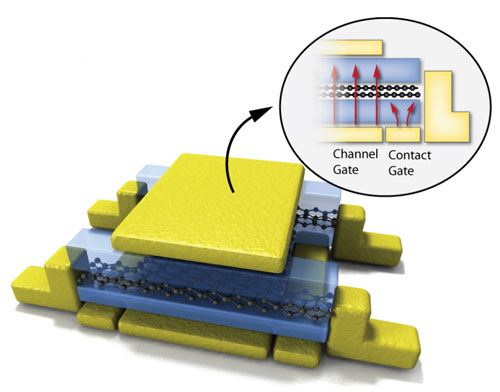| Posted: Jul 03, 2014 |
Researchers observe tunable quantum behavior in bilayer graphene
|
|
(Nanowerk News) Columbia researchers have observed the fractional quantum Hall effect in bilayer graphene and shown that this exotic state of matter can be tuned by an electric field.
|
|
The fractional quantum Hall effect, which can occur when electrons confined to thin sheets are exposed to large magnetic fields, is a striking example of collective behavior where thousands of individual electrons behave as a single system. However, while the basic theory describing this effect is well established, many details of this collective behavior remain not well understood, in part because it is only observable in systems with extremely low disorder.
|
 |
| An illustration of the novel geometry that enabled measurement of the tunable fractional quantum Hall effect in bilayer graphene. (Image: Columbia University)
|
|
Graphene, an atomically thin sheet of carbon, is a promising material for study of the fractional quantum Hall effect both because it can it be a nearly defect-free crystal, and because researchers can 'tune' the charge density with an external metal 'gate' electrode and observe how the quantum states evolve in response. Over the past several years, a collaborative effort at Columbia University spanning researchers from Mechanical Engineering, Electrical Engineering and Physics, developed a series of breakthrough fabrication techniques in order to take advantage of this opportunity, allowing them to report the first observation of the fractional quantum Hall effect in graphene in 2009, and the first wide-range tuning of the effect in 2011.
|
|
An even more interesting system for study of the fractional quantum Hall effect is so-called bilayer graphene, which consists of two stacked graphene sheets. In this material, use of two metal gate electrodes (above and below) allows independent tuning of the charge density in each layer, which provides a completely new way to manipulate the fractional quantum Hall states. In particular, theory predicts that it should be possible to create exotic 'non-abelian' states that could be used for quantum computation.
|
|
While observation of the fractional quantum Hall effect in single layer graphene required simply making cleaner devices, observing this effect in bilayer graphene proved more difficult. "We knew that we could fabricate very clean bilayer graphene structures, but we suffered from our inability to make good electrical contact since bilayer graphene develops an electronic 'band-gap' under the high magnetic fields and low temperatures required for our experiments," says Cory Dean, professor of Physics who recently moved to Columbia University, and lead author on the paper. A critical breakthrough was re-design of the devices so that the charge density in the contact regions could be tuned independently from the rest of the device, which allowed them to maintain good electrical contact even under large magnetic fields. "Once we had this new device structure the results were spectacular."
|
|
Reporting in the July 4, 2014 edition of Science ("Tunable fractional quantum Hall phases in bilayer graphene"), the team demonstrates the existence of the fractional quantum Hall effect in bilayer graphene and shows evidence of a controllable phase transition by application of electric fields. One of the key questions towards understanding the fractional quantum Hall effect in any system is to identify the order associated with the ground state. For example, do all electrons associated within the collective state carry the same spin? In bilayer graphene this question is more complex since there are several degrees of symmetry at play all at once. In addition to spin, electrons can polarize by spontaneously residing entirely on one layer versus the other.
|
|
This complexity provides an interesting new phase space to explore for new and unusual effects. In particular, several theories have predicted that application of electric fields to bilayer graphene could enable transitions between these ground state orders. "This is a new experimental knob that just is not available in other systems," says James Hone, a professor of Mechanical Engineering and co-author on the paper. The team has confirmed for the first time that varying the applied electric field causes a phase transition, but the exact nature of these different phases remains an open question. "While theory expects that we can tune the ground state order, the complexity of the system makes it difficult to determine exactly which order is actually realized," says Physics Professor and co-author Philip Kim.
|
|
"This is where the next phase of our research is headed," says Dean. "The implications for this result could be far reaching," he adds, "While we do not yet see any evidence of non-abelian states, the fact that we are able to modify the nature of the fractional quantum Hall effect by electric fields is a really exciting first step."
|
|
While previous efforts have been able to demonstrate different aspects of the sample requirement, no other group has been able to bring this all together into a single device. Dean attributes this success to the unique collaborative environment fostered at Columbia University. "This is truly a remarkable environment," he says, adding, "The open exchange of ideas across several disciplines makes the environment at Columbia a fertile ground for doing great science." Device fabrication and initial testing was done at Columbia University. Measurement under large magnetic fields was then performed by the Columbia team with the aid of the National High Magnetic Field Laboratory user facility in Tallahassee, Florida. "We have established a fantastic relationship with the NHFML over many years," says Dean. "The support provided by the NHMFL personnel at both the technical and scientific level has been invaluable to our efforts."
|

